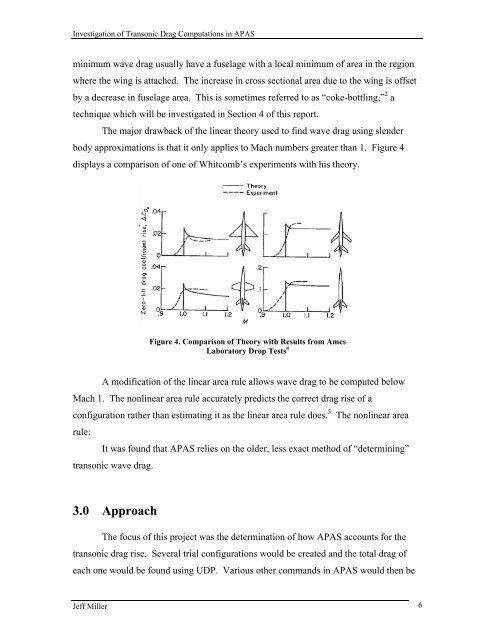Investigation of Transonic Drag Computations in Aerodynamic ...
Investigation of Transonic Drag Computations in Aerodynamic ...
Investigation of Transonic Drag Computations in Aerodynamic ...
You also want an ePaper? Increase the reach of your titles
YUMPU automatically turns print PDFs into web optimized ePapers that Google loves.
<strong>Investigation</strong> <strong>of</strong> <strong>Transonic</strong> <strong>Drag</strong> <strong>Computations</strong> <strong>in</strong> APAS<br />
m<strong>in</strong>imum wave drag usually have a fuselage with a local m<strong>in</strong>imum <strong>of</strong> area <strong>in</strong> the region<br />
where the w<strong>in</strong>g is attached. The <strong>in</strong>crease <strong>in</strong> cross sectional area due to the w<strong>in</strong>g is <strong>of</strong>fset<br />
by a decrease <strong>in</strong> fuselage area. This is sometimes referred to as “coke-bottl<strong>in</strong>g,” 2 a<br />
technique which will be <strong>in</strong>vestigated <strong>in</strong> Section 4 <strong>of</strong> this report.<br />
The major drawback <strong>of</strong> the l<strong>in</strong>ear theory used to f<strong>in</strong>d wave drag us<strong>in</strong>g slender<br />
body approximations is that it only applies to Mach numbers greater than 1. Figure 4<br />
displays a comparison <strong>of</strong> one <strong>of</strong> Whitcomb’s experiments with his theory.<br />
Figure 4. Comparison <strong>of</strong> Theory with Results from Ames<br />
Laboratory Drop Tests 4<br />
A modification <strong>of</strong> the l<strong>in</strong>ear area rule allows wave drag to be computed below<br />
Mach 1. The nonl<strong>in</strong>ear area rule accurately predicts the correct drag rise <strong>of</strong> a<br />
configuration rather than estimat<strong>in</strong>g it as the l<strong>in</strong>ear area rule does. 5 The nonl<strong>in</strong>ear area<br />
rule:<br />
It was found that APAS relies on the older, less exact method <strong>of</strong> “determ<strong>in</strong><strong>in</strong>g”<br />
transonic wave drag.<br />
3.0 Approach<br />
The focus <strong>of</strong> this project was the determ<strong>in</strong>ation <strong>of</strong> how APAS accounts for the<br />
transonic drag rise. Several trial configurations would be created and the total drag <strong>of</strong><br />
each one would be found us<strong>in</strong>g UDP. Various other commands <strong>in</strong> APAS would then be<br />
Jeff Miller 6
















